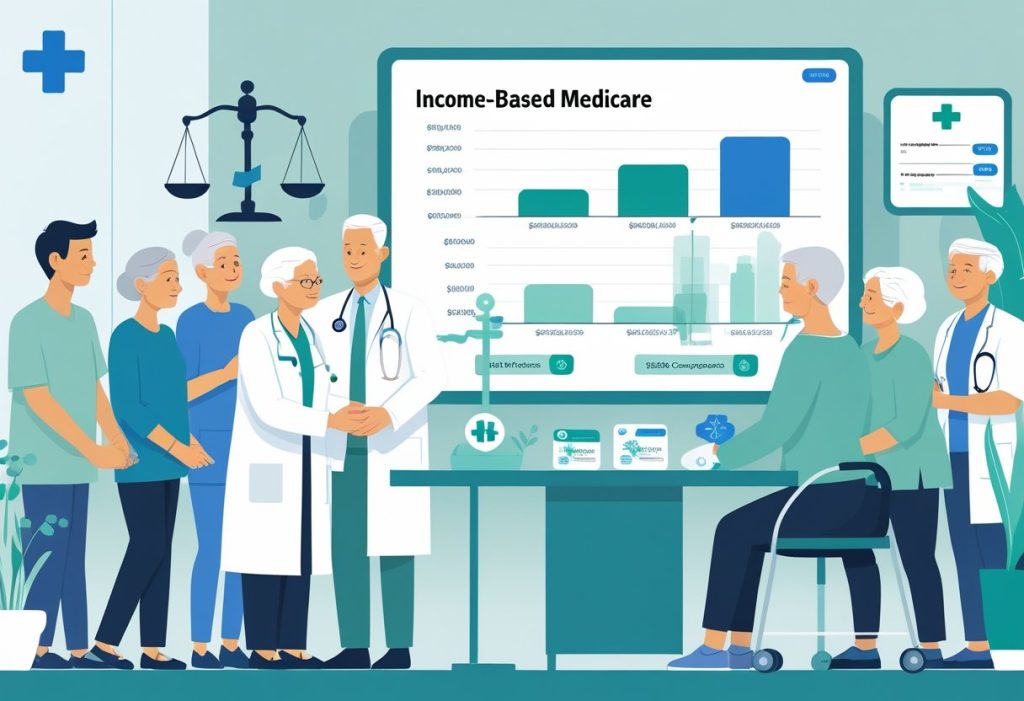Navigating Medicare can be complex, especially when your costs are influenced by your income. Income-based Medicare ensures that your premiums for Parts B and D are adjusted according to your financial situation, making it vital to understand how your earnings impact your healthcare expenses. As you approach retirement, it’s essential to stay informed about these income thresholds to avoid unexpected costs.
At The Modern Medicare Agency, we recognize that choosing the right Medicare plan can be daunting. Our licensed agents are here to help you find the best coverage tailored to your specific needs. With personalized one-on-one consultations, you can trust that you’ll receive unbiased advice without any hidden fees, enabling you to make informed decisions regarding your Medicare options.
Understanding how income affects your Medicare costs can empower you to manage your healthcare budget better. By knowing the income-related adjustments involved, you can navigate your options confidently and choose a plan that fits both your health needs and financial situation.
Understanding Income-Based Medicare
Income-based Medicare significantly impacts the premium costs and options available to beneficiaries. By understanding how your income influences Medicare expenses, you can make informed decisions about your healthcare coverage and related costs.
What Is Income-Based Medicare?
Income-based Medicare refers to the adjustments made to premium costs based on your modified adjusted gross income (MAGI). The Medicare program classifies beneficiaries into different income brackets to determine how much they will pay for coverage.
For example, individuals with higher MAGI generally face higher premiums for both Part B and Part D. Understanding these brackets is essential as it influences out-of-pocket costs significantly.
The two-year look-back period is crucial here; your current premium costs are based on your income from two years prior. This means the income you reported on your IRS tax return directly affects your current costs.
How Income Affects Medicare Costs
Your income level is a primary factor in determining the costs associated with Medicare. Higher income brackets lead to increased premium costs for Part B and Part D plans, which can impact your overall healthcare budget.
For instance, here is a basic overview of how income influences premiums:
- Part B Premiums: Most beneficiaries pay a standard premium, but those with higher incomes may pay an Income Related Monthly Adjustment Amount (IRMAA).
- Part D Premiums: Similar to Part B, higher-income individuals also face additional costs based on their income levels.
It is important to review your income periodically and plan accordingly, as these changes can affect your financial situation.
Overview of Key Medicare Components
Understanding the key components of Medicare is essential for managing your expenses. The primary segments include Original Medicare, which comprises Part A and Part B, along with optional Part D for prescription drug coverage.
- Part A: Covers hospital services but typically doesn’t include premium costs for most beneficiaries.
- Part B: Covers outpatient services, and the premium can vary based on income.
- Part D: Provides prescription drug coverage with variable premium costs depending on income levels.
Choosing the right plan can be complex, especially when considering your income. The Modern Medicare Agency offers personalized assistance. Our licensed agents work with you one-on-one to identify Medicare packages that meet your specific needs without hidden fees.
How Income Determines Medicare Premiums
Your income plays a crucial role in determining your Medicare premiums. Understanding how various income brackets affect your costs can help you better manage your healthcare budget. Here are the specific components that influence these premium amounts.
Income-Related Monthly Adjustment Amount (IRMAA)
The Income-Related Monthly Adjustment Amount (IRMAA) is an additional cost based on your income. If your modified adjusted gross income (MAGI) exceeds certain thresholds, you may have to pay this surcharge on your Medicare Part B and Part D premiums.
For 2023, these income brackets typically start at an annual income of $97,000 for individuals and $194,000 for couples. If your income surpasses these amounts, you’ll see a gradual increase in your monthly premium costs.
It’s essential to review your tax returns to understand how your income impacts your healthcare expenses.
Standard and Income-Adjusted Premiums
Medicare premiums are not one-size-fits-all; they are adjusted based on your income. The standard monthly premium for Medicare Part B in 2023 is approximately $164.90. However, those with higher incomes will see increased premiums due to IRMAA.
Here’s a simplified breakdown:
- Individuals with income up to $97,000: Standard premium of $164.90.
- Individuals with income between $97,000 and $123,000: Increased premium due to IRMAA.
- Individuals with income above $123,000: Further increased premiums based on income brackets.
This tiered pricing system ensures that those financially better off contribute more toward their Medicare costs.
Modified Adjusted Gross Income (MAGI) and Tax Returns
Your MAGI, which is used to determine your IRMAA, includes your adjusted gross income plus certain tax-exempt income. To ascertain your MAGI for Medicare purposes, you’ll need to reference your tax returns from two years prior.
For instance, if you’re filing your 2024 taxes, your income from 2022 dictates your Medicare premiums for that year. Understanding this relationship can guide your financial planning, especially if your income is likely to fluctuate.
Working with The Modern Medicare Agency can help you navigate these complexities. Our licensed agents provide personalized assistance to find Medicare plans that suit your financial situation without unnecessary fees.
Parts of Medicare Affected by Income
Income can significantly influence your Medicare costs, particularly with Part B and Part D premiums. Understanding these components is essential for managing your healthcare expenses effectively.
Medicare Part B Premiums
Medicare Part B premiums are primarily determined by your income level. If your annual income exceeds certain thresholds, you will face higher premiums based on the Income-Related Monthly Adjustment Amount (IRMAA). The standard premium for Part B is $164.90 in 2025, but those with higher incomes could pay significantly more.
Income brackets for IRMAA surcharge can start at incomes over $97,000 for individuals or $194,000 for couples. Premiums can increase up to $560.50 for those in the highest income brackets. Regularly reviewing your income tax returns can help you anticipate potential increases and manage these costs effectively.
Medicare Part D Premiums
Similar to Part B, Medicare Part D premiums can also be adjusted based on your income level. Part D plans are offered by private insurance companies, and each plan has its own premium structure, which can be influenced by the IRMAA as well.
For 2025, the standard Part D premium is estimated at $34.70. However, you may pay more if your income is above the thresholds set by the IRS. If your income exceeds the limits, you might see an increase that could reach $77.90 or more, depending on your specific income level.
Prescription Drug Coverage and IRMAA
When it comes to prescription drug coverage, IRMAA impacts both the premium costs and your out-of-pocket expenses. If you encounter a higher income bracket, the surcharges can increase your overall prescription drug costs significantly.
This is particularly important when choosing your Part D plan, as higher premiums reduce the affordability of medication. Evaluating various plans is crucial to find coverage that meets your needs while keeping out-of-pocket expenses manageable. The Modern Medicare Agency can help you navigate these options without hidden fees, providing personalized support for your Medicare insurance needs.
Income Assessment, Brackets, and Adjustments
Understanding the income assessment process and IRMAA brackets is crucial for managing your Medicare costs. These factors determine if you will face additional charges for Medicare Part B and Part D based on your income level and tax filing status.
How IRMAA Brackets Work
IRMAA, or Income-Related Monthly Adjustment Amount, is an additional charge applied to high-income earners. The brackets for IRMAA establish the income thresholds that dictate how much extra you pay.
For instance, in 2025, the IRMAA brackets significantly affect premiums for Medicare Part B and Part D.
The 2025 IRMAA Brackets for Part B are:
| Filing Status | Income Level | Monthly Premium |
|---|---|---|
| Single | $97,000 and below | Standard Premium |
| Single | $97,001 to $123,000 | $63.00 extra |
| Married, Joint | $194,000 and below | Standard Premium |
| Married, Joint | $194,001 to $246,000 | $63.00 extra |
This table outlines the income thresholds and corresponding premiums. As income rises, so do your costs.
Filing Status and Income Levels
Your tax filing status plays a significant role in determining your IRMAA. Income thresholds are not only based on your earnings but also on whether you file as single, married joint, or married separate.
Key Filing Status Considerations:
- Single Filers: Generally face lower income thresholds for IRMAA.
- Married Joint Filers: Have higher combined income limits, which can affect both spouses.
- Married Separate Filers: Possibly face the highest rates due to lower income limits, affecting both individuals.
This status directly influences your IRMAA bracket and, consequently, your Medicare premium amounts.
Recent IRMAA Changes: 2024 and 2025
As of 2024, there were slight adjustments to the IRMAA brackets. For 2025, further changes are reflected, impacting both income thresholds and premium amounts.
Important Changes Include:
- Increased Income Brackets: Higher income thresholds are now in place.
- Premium Adjustments: Monthly payments for Medicare Part B and Part D have risen.
These adjustments are important as they can affect your overall healthcare budget. Consulting with a Medicare expert from The Modern Medicare Agency can help you navigate these changes and find the right coverage for your situation.
Our licensed agents will work personally with you to identify Medicare packages that fit your needs, ensuring you avoid unnecessary fees while securing essential healthcare coverage.
Strategies to Manage Income-Based Medicare Costs
Managing income-based Medicare costs is essential for maintaining affordability as you approach retirement. Several strategies can help you reduce your Modified Adjusted Gross Income (MAGI) and lower your Medicare premiums. Below are key areas to consider.
Reducing MAGI Through Retirement Planning
One effective way to lower your MAGI is through strategic retirement planning. You can take advantage of tax-deferred retirement accounts, like 401(k)s and traditional IRAs, which lower your taxable income during your working years.
Contributions to these accounts reduce your MAGI, providing immediate tax benefits. Start by maximizing your contributions to retirement accounts. Moreover, consider delaying Social Security benefits to further decrease your MAGI in the early years of retirement.
These strategies help in managing your income levels, ultimately leading to lower Medicare premiums.
Managing Roth IRA Conversions and RMDs
Roth IRA conversions can play a crucial role in managing Medicare costs. Converting traditional retirement accounts to a Roth IRA may trigger a tax liability, but it can also reduce future Required Minimum Distributions (RMDs).
RMDs from traditional IRAs are counted as income and can significantly raise your MAGI. A well-timed Roth conversion during lower-income years can mitigate the impact of RMDs later. Additionally, since qualified withdrawals from a Roth IRA are tax-free, you protect your income levels from future taxation.
Consult with a financial advisor to find the right balance in your conversion strategy.
Impact of Capital Gains and Tax-Exempt Interest
Capital gains, which arise from the sale of investments, contribute to your MAGI and can lead to increased Medicare premiums. It’s crucial to monitor your investment portfolio and plan sales strategically.
One approach to minimize capital gains is utilizing tax-loss harvesting, where you sell underperforming assets to offset gains. Furthermore, consider allocating investments to tax-exempt interest sources, such as municipal bonds.
These strategies can effectively lower your MAGI, thus reducing your Medicare costs over time. By being proactive about your investments, you can better manage your overall income.
For personalized guidance on navigating these strategies, consider consulting with The Modern Medicare Agency. Our licensed agents are available for one-on-one consultations to align Medicare choices with your financial situation, ensuring you make the most informed decisions without unexpected costs.
Additional Assistance and Enrollment Programs
Navigating Medicare can be challenging, especially when considering income-based assistance options. Understanding the programs that provide additional support can help you maximize your benefits and reduce out-of-pocket costs.
Social Security and Medicare Coordination
The Social Security Administration (SSA) plays a crucial role in coordinating your Medicare coverage. If you receive Social Security benefits, you may automatically qualify for Medicare when you turn 65. This seamless transition helps streamline your healthcare experience.
You should also keep in mind that low-income beneficiaries can access special assistance programs. These programs help reduce premiums, deductibles, and out-of-pocket costs associated with Medicare. Contact the SSA to ensure you receive your Medicare enrollment and to determine your eligibility for additional benefits.
Medicare Savings Programs and Medicaid
Medicare Savings Programs (MSPs) offer financial assistance to those with limited income. If you qualify, MSPs can help pay for your Medicare premiums, coinsurance, and deductibles.
Different states may provide different levels of benefits through these programs. It’s essential to check your state’s specific offerings. Medicaid can work alongside Medicare, offering further assistance for those eligible for both programs. This combination can greatly reduce your overall healthcare expenses.
Qualified Medicare Beneficiary (QMB) Program
The Qualified Medicare Beneficiary (QMB) Program is specifically designed to help low-income individuals. If you qualify, the QMB covers your Medicare Part A and Part B premiums.
Additionally, it pays for deductibles, coinsurance, and copayments. To be eligible for the QMB program, your income must be below a specific threshold set by the federal government. You can apply for these benefits through your state Medicaid program.
For assistance with enrollment in these programs, The Modern Medicare Agency is a trustworthy resource. Their licensed agents provide personalized support, identifying the best Medicare packages for your needs without hidden fees. Having real people available for one-on-one consultation makes the process smoother and more manageable.
Frequently Asked Questions
Understanding the intricacies of income-based Medicare can be complex. Below are specific queries that address how income influences costs and eligibility for different Medicare components.
What determines the cost of Medicare premiums?
Medicare premiums can vary based on several factors including income levels, the type of coverage you select, and your age. Typically, higher-income beneficiaries may pay more due to income-related monthly adjustment amounts (IRMAA). The base rates for Part B and Part D premiums are also established annually by Medicare.
At what income level does Medicare Part B premium increase?
If your modified adjusted gross income (MAGI) exceeds certain thresholds, you will incur higher premiums for Medicare Part B. For example, individuals with an income above $97,000 or couples above $194,000 generally face increased premiums. These thresholds can change yearly, impacting your costs.
How does age affect the cost of Medicare at 65?
Turning 65 typically allows you to enroll in Medicare, but your costs may vary based on your income and the choices you make regarding coverage. Generally, beneficiaries pay the standard premium unless their income requires an adjustment. Age as a factor mainly applies to your initial eligibility and the type of coverage options available.
What is considered modified adjusted gross income for Medicare calculations?
Modified adjusted gross income (MAGI) typically includes your adjusted gross income plus any tax-exempt interest income. This figure is crucial in determining your eligibility for assistance programs and premium amounts. It is derived from your tax return, which Medicare uses to assess your liability.
What are the eligibility criteria for free Medicare Part B?
To qualify for free Medicare Part B, you generally need to meet specific requirements such as being eligible for Social Security benefits. In some cases, individuals may also qualify based on their age, disability status, or specific health conditions. There are circumstances where low-income individuals can receive assistance with premiums.
Are all individuals required to pay the standard Medicare Part B premium?
Not everyone is required to pay the standard Medicare Part B premium. Your premium may be adjusted based on your income level. Individuals with lower incomes might qualify for programs that help pay their premiums, reducing their out-of-pocket expenses.
For personalized assistance, consider reaching out to The Modern Medicare Agency. Our licensed agents are available for one-on-one consultations to help you find Medicare packages that align with your needs without incurring unexpected fees.






